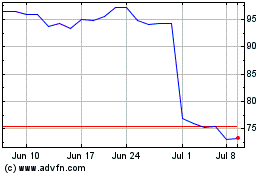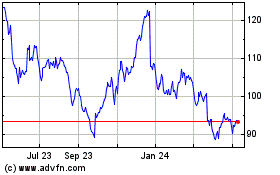By Ellen Emmerentze Jervell
T-shirts and bluejeans have company among casual clothes gone
Establishment: sneakers.
Athletic shoes have become core lifestyle footwear, not only in
street culture but also for fashionistas and corporate types.
Sneakers are more commonly being paired with men's suits. And it's
the retro styles that are raising the game for shoe makers.
Skaters, celebrities and brides are posting pictures of themselves
on social media in sneakers such as the signature styles Kareem
Abdul-Jabbar and Billie Jean King wore.
"They've finally been around long enough to become classic,"
says Russ Bengtson, senior editor at urban-culture site
Complex.com.
Reissued or "heritage" shoes were the fastest-growing footwear
category in the U.S. last year, according to analysts NPD Group,
which estimates sector sales rose more than 50% and accounted for
about 20% of the $17.2 billion U.S. athletic footwear market.
It is good news for Germany's venerable Adidas AG and Puma SE,
which are working to reprise their classics. Both companies have
struggled to regain their disco-era cool in today's highly
competitive market, and each has seven decades of products to
mine.
At Adidas, the world's second-largest sportswear maker after
Nike Inc., the cash cow is a range of leather tennis and basketball
shoes dating back to the 1960s. Now part of the company's
'Originals' business, the line is "the backbone of our success,"
says Arthur Hoeld, Originals general manager.
Originals' surge was a top reason Adidas last year achieved
sales growth of almost 20% from 2014, the company says. Overall
revenue for 2015 was EUR16.9 billion ($19.12 billion); Originals
grew at a "double digit" percentage rate. The rise included a
strong rebound in the U.S., where Adidas has struggled.
Adidas says it sold 8 million pairs of its Stan Smiths last year
-- compared with about 50 million pairs sold in the past
half-century. The company also sold 15 million pairs of Superstars
in 2015, with Adidas's signature triple stripe. Both models average
about $70.
"They're the crown jewels," says Mr. Hoeld of the heritage
shoes.
Puma CEO Bjørn Gulden is more circumspect.
"Heritage sneakers are an important part of our business," but
perhaps not for long, he says. "Trends come and go." He noted that
retro basketball shoes are hot now, while retro running shoes were
recently trendier.
Puma's 2015 revenue was EUR3.4 billion, up from EUR2.9 billion a
year earlier.
The retro-style trend has been decades in the making. In 1982,
rap duo Run-DMC's hit "My Adidas" breathed life into the company's
decade-old Superstar line. "I wanted to bring a positive
representation to the sneakers that break dancers, DJs, MC's and
the graffiti writers were wearing," says Darryl McDaniels, who goes
by DMC and still wears Adidas.
When Madonna a decade later performed in old Adidas Gazelle
sneakers, the company upped production of past best-sellers.
Nike jumped on Michael Jordan's retirement in 1994 to reissue
its Air Jordan basketball shoes from the 1980s. It did so again in
1998 when he retired a second time.
Today, sport shoes are generally split between "performance"
models aimed at serious athletes and "lifestyle" footwear for
people who don't necessarily aim to break a sweat. Many of today's
lifestyle shoes are yesteryear's performance models.
Nike, whose most popular back-catalog items stem from the 1980s
and '90s, has long been more aggressive at marketing and
capitalizing on its retro products than Adidas or Puma, says John
Guy, an analyst at MainFirst bank. Nike still sells more heritage
sneakers than any rival, says NPD analyst Matt Powell.
Nike also owns Converse's Chuck Taylor All-Stars, introduced
nearly 100 years ago, which have long been in demand.
Nike says it saw "strong value in celebrating our heritage,"
according to a spokesman, though reissued models use new materials
and construction. Today's Nike's Air Max and Air Jordan retail for
about $150 and $100, respectively.
What distinguishes today's renaissance is who's sporting sport
shoes. Older sneakers from Adidas and Puma are kicking aside
traditional dress shoes and opening new sartorial frontiers.
When Adidas relaunched Stan Smiths in 2014, it wooed the fashion
world. High-end designers Phoebe Philo, Raf Simons and Marc Jacobs
all wore the white-and-green leather sneaker. U.S. designer
Alexander Wang presented catwalk outfits inspired by the shoe.
Nike's retro sales, such as past resurgences of Adidas and other
heritage brands, largely have focused on young and athletic buyers.
"Adidas is targeting a broader range of consumers," says Matt
Halfhill, founder of sneaker site Nicekicks.com.
Adidas appears to have a leg up on Nike in respectable retro,
observers say, because its sneakers date back to when baby boomers
were babies. Stan Smith played tennis when rackets were made of
wood and sportswear essentially was modified casual attire.
Adidas's retro models are "kind of 'pre-style,'" says Mr.
Bengtson at Complex.com. "People aren't going to stop you on the
street and say 'Ew, that's awful'."
A delicate issue brands face managing the current fad is
avoiding overexposure. Adidas executives admit they mishandled
their Run-DMC lift by flooding the market and killing their own
cachet.
Mr. Hoeld at Adidas says the company is managing retro
popularity in "a very cohesive manner," with a steady flow of
variations to maintain interest.
Most important, says Mr. Gulden at Puma, is to limit marketing
exuberance and "have a good balance between performance, new
lifestyle shoes and heritage."
Write to Ellen Emmerentze Jervell at ellen.jervell@wsj.com
(END) Dow Jones Newswires
June 20, 2016 15:33 ET (19:33 GMT)
Copyright (c) 2016 Dow Jones & Company, Inc.
Nike (NYSE:NKE)
Historical Stock Chart
From Mar 2024 to Apr 2024

Nike (NYSE:NKE)
Historical Stock Chart
From Apr 2023 to Apr 2024
